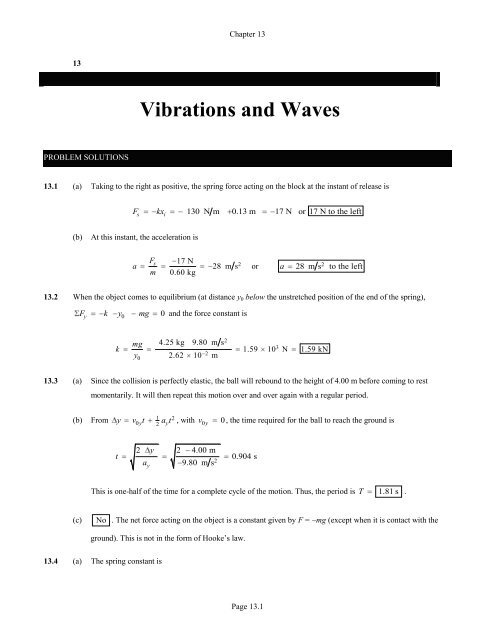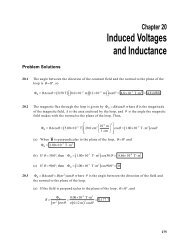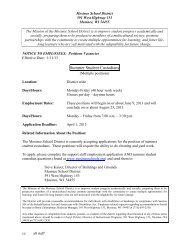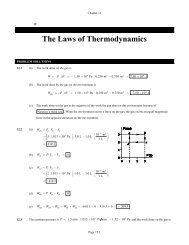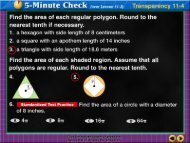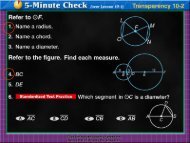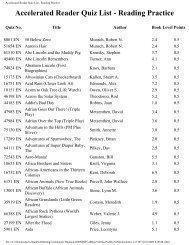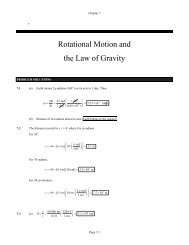Chapter 13 Solutions - Mosinee School District
Chapter 13 Solutions - Mosinee School District
Chapter 13 Solutions - Mosinee School District
Create successful ePaper yourself
Turn your PDF publications into a flip-book with our unique Google optimized e-Paper software.
<strong>Chapter</strong> <strong>13</strong><br />
<strong>13</strong><br />
Vibrations and Waves<br />
PROBLEM SOLUTIONS<br />
<strong>13</strong>.1 (a) Taking to the right as positive, the spring force acting on the block at the instant of release is<br />
F kx<br />
s<br />
i<br />
<strong>13</strong>0 N m 0.<strong>13</strong> m 17 N or 17 N to the left<br />
(b)<br />
At this instant, the acceleration is<br />
a<br />
F s<br />
m<br />
17 N<br />
0.60 kg<br />
28 m s<br />
2<br />
or a 28 m s<br />
2<br />
to the left<br />
<strong>13</strong>.2 When the object comes to equilibrium (at distance y 0 below the unstretched position of the end of the spring),<br />
F k y mg and the force constant is<br />
y<br />
0 0<br />
k<br />
mg<br />
y<br />
0<br />
4.25 kg 9.80 m s<br />
2.62 10<br />
2<br />
m<br />
2<br />
1.59 103<br />
N 1.59 kN<br />
<strong>13</strong>.3 (a) Since the collision is perfectly elastic, the ball will rebound to the height of 4.00 m before coming to rest<br />
momentarily. It will then repeat this motion over and over again with a regular period.<br />
1<br />
(b) From y v t a t<br />
2<br />
, with v 0 0 , the time required for the ball to reach the ground is<br />
0y<br />
2<br />
y<br />
y<br />
t<br />
2 y 2 4.00 m<br />
a<br />
y<br />
9.80 m s<br />
2<br />
0.904 s<br />
This is one-half of the time for a complete cycle of the motion. Thus, the period is<br />
T 1.81 s .<br />
(c)<br />
No . The net force acting on the object is a constant given by F = mg (except when it is contact with the<br />
ground). This is not in the form of Hooke’s law.<br />
<strong>13</strong>.4 (a) The spring constant is<br />
Page <strong>13</strong>.1
<strong>Chapter</strong> <strong>13</strong><br />
k<br />
Fs<br />
x<br />
mg<br />
x<br />
50 N<br />
5.0 10<br />
-2<br />
m<br />
1.0 103<br />
N m<br />
F Fs<br />
kx<br />
1.0 103 N m 0.11 m 1.1 102<br />
N<br />
(b) The graph will be a straight line passing through the origin with a slope equal to k 1.0 103<br />
N m .<br />
<strong>13</strong>.5 When the system is in equilibrium, the tension in the spring F k x must equal the weight of the object. Thus,<br />
k x<br />
mg giving<br />
m<br />
k x<br />
g<br />
47.5 N 5.00 10<br />
2<br />
m<br />
9.80 m s<br />
2<br />
0.242 kg<br />
<strong>13</strong>.6 (a) The free-body diagram of the point in the center of the string is<br />
given at the right. From this, we see that<br />
F 0 F 2T<br />
sin 35.0 0<br />
x<br />
or<br />
T<br />
F 375 N<br />
2 sin 35.0 2 sin 35.0<br />
327 N<br />
(b)<br />
Since the bow requires an applied horizontal force of 375 N to hold the string at 35.0° from the vertical, the<br />
tension in the spring must be 375 N when the spring is stretched 30.0 cm. Thus, the spring constant is<br />
k<br />
F<br />
x<br />
375 N<br />
0.300 m<br />
1.25 103<br />
N m<br />
<strong>13</strong>.7 (a) When the block comes to equilibrium, Fy<br />
ky0 mg 0 giving<br />
y<br />
0<br />
mg<br />
k<br />
10.0 kg 9.80 m s<br />
475 N m<br />
2<br />
0.206 m<br />
or the equilibrium position is 0.206 m below the unstretched position of the lower end of the spring.<br />
(b) When the elevator (and everything in it) has an upward acceleration of a 2.00 m s2<br />
second law to the block gives<br />
, applying Newton’s<br />
Fy<br />
k y0<br />
y mg ma y or y 0<br />
F ky mg ky ma<br />
y<br />
Page <strong>13</strong>.2
<strong>Chapter</strong> <strong>13</strong><br />
where y = 0 at the equilibrium position of the block. Since ky0 mg 0 [see part (a)], this becomes<br />
ky<br />
ma and the new position of the block is<br />
y<br />
ma y<br />
k<br />
10.0 kg 2.00 m s<br />
475 N m<br />
2<br />
4.21 10<br />
2<br />
m 4.21 cm<br />
or 4.21 cm below the equilibrium position.<br />
(c)<br />
When the cable breaks, the elevator and its contents will be in free-fall with a y = g. The new “equilibrium”<br />
position of the block is found from Fy<br />
ky0<br />
mg m g , which yields y 0 0<br />
snapped, the block was at rest relative to the elevator at distance<br />
. When the cable<br />
y0 y 0.206 m 0.042 1 m 0.248 mbelow the new “equilibrium” position. Thus, while the elevator is<br />
in free-fall, the block will oscillate with amplitude<br />
0.248 m about the new “equilibrium” position, which<br />
is the unstretched position of the spring’s lower end.<br />
<strong>13</strong>.8 (a) When the gun is fired, the elastic potential energy initially stored in the spring is transformed into kinetic<br />
energy of the projectile. Thus, it is necessary to have<br />
1<br />
2<br />
1<br />
kx<br />
2<br />
0 mv 0 or<br />
2 2<br />
k<br />
mv<br />
x<br />
2<br />
0<br />
2<br />
0<br />
3.00 10<br />
3<br />
kg 45.0 m s<br />
2<br />
8.00 10<br />
2<br />
m<br />
2<br />
949 N m<br />
(b)<br />
The magnitude of the force required to compress the spring 8.00 cm and load the gun is<br />
Fs<br />
k x<br />
949 N m 8.00 10<br />
2<br />
m 75.9 N<br />
<strong>13</strong>.9 (a) Assume the rubber bands obey Hooke’s law. Then, the force constant of each band is<br />
k<br />
F s<br />
x<br />
15 N<br />
1.0 10<br />
-2<br />
m<br />
1.5 103<br />
N m<br />
Thus, when both bands are stretched 0.20 m, the total elastic potential energy is<br />
1<br />
PEs<br />
kx<br />
2<br />
2 3<br />
2<br />
2 1.5 10 N m 0.20 m 60 J<br />
(b) Conservation of mechanical energy gives KE PE s KE PE s , or<br />
f<br />
i<br />
Page <strong>13</strong>.3
<strong>Chapter</strong> <strong>13</strong><br />
1<br />
2<br />
0 0 60 J<br />
2 mv , so 2 60 J<br />
v<br />
50 10<br />
-3<br />
kg<br />
49 m s<br />
<strong>13</strong>.10 (a)<br />
k<br />
F<br />
x<br />
max<br />
max<br />
230 N<br />
0.400 m<br />
575 N m<br />
(b)<br />
work done PEs<br />
kx<br />
2 2<br />
1<br />
2<br />
1 2<br />
575 N m 0.400 46.0 J<br />
<strong>13</strong>.11 From conservation of mechanical energy,<br />
KE PE g PE s KE PE f<br />
g PE s or 1<br />
0 mghf<br />
0 0 0 kx i<br />
2<br />
i<br />
2<br />
giving<br />
k<br />
2 mgh<br />
x<br />
2<br />
i<br />
f<br />
2 0.100 kg 9.80 m s2<br />
0.600 m<br />
2<br />
2.00 10<br />
2<br />
m<br />
2.94 103<br />
N m<br />
<strong>13</strong>.12 Conservation of mechanical energy, ( KE PEg PEs ) f ( KE PEg PE s)<br />
i<br />
, gives<br />
1 2 1<br />
mv 0 0 0 0<br />
2<br />
2 i<br />
2 f<br />
kx , or<br />
v<br />
i<br />
k<br />
m<br />
x<br />
i<br />
5.00 106<br />
N m 3.16 10<br />
2 m 2.23 m s<br />
1000 kg<br />
<strong>13</strong>.<strong>13</strong> An unknown quantity of mechanical energy is converted into internal energy during the collision. Thus, we apply<br />
conservation of momentum from just before to just after the collision and obtain mv i + M(0) = (M + m)V, or the<br />
speed of the block and embedded bullet just after collision is<br />
V<br />
m<br />
M m<br />
v<br />
i<br />
10.0 10<br />
3<br />
kg<br />
2.01 kg<br />
300 m s 1.49 m s<br />
Now, we use conservation of mechanical energy from just after collision until the block comes to rest. This gives<br />
1 2 1<br />
0<br />
2<br />
2 f 2<br />
kx M m V , or<br />
x<br />
f<br />
V<br />
M m<br />
k<br />
2.01 kg<br />
1.49 m s 0.477 m<br />
19.6 N m<br />
Page <strong>13</strong>.4
<strong>Chapter</strong> <strong>13</strong><br />
<strong>13</strong>.14 (a) At either of the turning points, x = A, the constant total energy of the system is momentarily stored as elastic<br />
potential energy in the spring. Thus, E kA 2 2 .<br />
(b) When the object is distance x from the equilibrium position, the elastic potential energy is PEs<br />
kx 2 2 and<br />
the kinetic energy is KE mv 2 2 . At the position where KE = 2PE s , is it necessary that<br />
1 1<br />
2 2<br />
1<br />
mv kx<br />
2<br />
mv2 2 kx<br />
2<br />
or<br />
2 2<br />
(c) When KE = 2PE, conservation of energy gives E KE PEs 2 PEs PEs 3PE s<br />
, or<br />
1 1<br />
2 2<br />
kA2 3 kx2<br />
x<br />
k A 2 2<br />
3 k 2<br />
or<br />
x<br />
A<br />
3<br />
<strong>13</strong>.15 (a) At maximum displacement from equilibrium, all of the energy is in the form of elastic potential energy, giving<br />
E kx , and<br />
3<br />
2<br />
max 2<br />
k<br />
2E<br />
x<br />
2<br />
max<br />
2 47.0 J<br />
0.240 m<br />
2<br />
1.63 10 N m<br />
(b)<br />
At the equilibrium position (x = 0), the spring is momentarily in its relaxed state and PE s = 0, so all of the<br />
energy is in the form of kinetic energy. This gives<br />
1<br />
KE mv2<br />
x 0<br />
max E<br />
2<br />
47.0 J<br />
(c)<br />
If, at the equilibrium position, v = v max = 3.45 m/s, the mass of the block is<br />
m<br />
2E<br />
v<br />
2<br />
max<br />
2 47.0 J<br />
3.45 m s<br />
2<br />
7.90 kg<br />
(d) At any position, the constant total energy is, E KE PE mv2 2 kx<br />
2<br />
2, so at x = 0.160 m<br />
s<br />
v<br />
2E<br />
2 2 47.0 J 1.63 103<br />
N m 0.160 m<br />
kx<br />
m<br />
7.90 kg<br />
2<br />
2.57 m s<br />
(e)<br />
At x = 0.160 m, where v = 2.57 m/s, the kinetic energy is<br />
Page <strong>13</strong>.5
<strong>Chapter</strong> <strong>13</strong><br />
1<br />
2<br />
1 2<br />
7.90 kg 2.57 m s 26.1 J<br />
KE mv<br />
2 2<br />
(f)<br />
At x = 0.160 m, where KE = 26.1 J, the elastic potential energy is<br />
PEs<br />
E KE<br />
47.0 J 26.1 J 20.9 J<br />
or alternately,<br />
1<br />
2<br />
1<br />
3<br />
2<br />
1.63 10 N m 0.160 m 20.9 J<br />
PEs<br />
kx<br />
2 2<br />
(g)<br />
At the first turning point (for which x < 0 since the block started from rest at x = +0.240 m and has passed<br />
through the equilibrium at x = 0) all of the remaining energy is in the form of elastic potential energy, so<br />
1<br />
2<br />
kx2<br />
E E loss<br />
47.0 J 14.0 J 33.0 J<br />
and<br />
x<br />
2 33.0 J 2 33.0 J<br />
k<br />
1.63 103<br />
N m<br />
0.201 m<br />
<strong>13</strong>.16 (a) F k x 83.8 N m 5.46 10<br />
2<br />
m 4.58 N<br />
(b)<br />
E PEs<br />
kx<br />
2 2<br />
1 2<br />
2<br />
1 83.8 N m 5.46 10<br />
2 m 0.125 J<br />
(c) While the block was held stationary at x = 5.46 cm, F F F 0 , or the spring force was equal in<br />
magnitude and oppositely directed to the applied force. When the applied force is suddenly removed, there is a<br />
net force F s = 4.58 N directed toward the equilibrium position acting on the block. This gives the block an<br />
acceleration having magnitude<br />
x<br />
s<br />
a<br />
F s<br />
m<br />
4.58 N<br />
0.250 kg<br />
18.3 m s<br />
2<br />
(d)<br />
At the equilibrium position, PE s = 0, so the block has kinetic energy KE = E = 0.125 J and speed<br />
v<br />
2E<br />
m<br />
2 0.125 J<br />
0.250 kg<br />
1.00 m s<br />
Page <strong>13</strong>.6
<strong>Chapter</strong> <strong>13</strong><br />
(e)<br />
If the surface was rough, the block would spend energy overcoming a retarding friction force as it moved<br />
toward the equilibrium position, causing it to arrive at that position with a lower speed than that computed<br />
above. Computing a number value for this lower speed requires knowledge of the coefficient of friction<br />
between the block and surface.<br />
<strong>13</strong>.17 From conservation of mechanical energy,<br />
KE PE PE KE PE PE<br />
g s<br />
f<br />
g s<br />
i<br />
we have 1 mv 2 0 1 kx 2 0 0<br />
1 kA 2 , or<br />
2 2 2<br />
k<br />
v A x<br />
m<br />
2 2<br />
(a) The speed is a maximum at the equilibrium position, x = 0.<br />
v<br />
max<br />
k<br />
A<br />
m<br />
2<br />
19.6 N m 2<br />
0.040 m 0.28 m s<br />
0.40 kg<br />
(b) When x = 0.015 m,<br />
v<br />
19.6 N m 2 2<br />
0.040 m 0.015 m 0.26 m s<br />
0.40 kg<br />
(c) When x = +0.015 m,<br />
v<br />
19.6 N m 2 2<br />
0.040 m 0.015 m 0.26 m s<br />
0.40 kg<br />
1<br />
k<br />
(d) If v v<br />
2 max<br />
, then<br />
2 2<br />
1 k<br />
A x A2<br />
m<br />
2 m<br />
This gives A 2 x 2 = A 2 /4, or x A 3 / 2 4.0 cm 3 / 2 3.5 cm .<br />
1<br />
<strong>13</strong>.18 (a) KE = 0 at x = A, so E KE PE 0 kA<br />
2<br />
, or the total energy is<br />
s<br />
2<br />
E<br />
1 2<br />
1 250 N m 0.035 m 2<br />
kA<br />
0.15 J<br />
2 2<br />
Page <strong>13</strong>.7
<strong>Chapter</strong> <strong>13</strong><br />
1<br />
(b) The maximum speed occurs at the equilibrium position where PE s = 0. Thus, E mv<br />
2<br />
2 max<br />
, or<br />
v<br />
max<br />
2 E k<br />
250 N m<br />
A 0.035 m 0.78 m s<br />
m m<br />
0.50 kg<br />
(c) The acceleration is a F/ m kx/<br />
m . Thus, a = a max at x = x max = A.<br />
a<br />
max<br />
k A k<br />
m m<br />
A<br />
250 N m 0.035 m 18 m s<br />
0.50 kg<br />
2<br />
<strong>13</strong>.19 The maximum speed occurs at the equilibrium position and is<br />
v<br />
max<br />
k<br />
m<br />
A<br />
Thus,<br />
m<br />
kA<br />
v<br />
2<br />
2<br />
max<br />
16.0 N m 0.200 m<br />
0.400 m s<br />
2<br />
2<br />
4.00 kg ,<br />
and<br />
Fg<br />
mg<br />
4.00 kg 9.80 m s2<br />
39.2 N<br />
<strong>13</strong>.20<br />
k<br />
v A x<br />
m<br />
2 2<br />
10.0 N m<br />
50.0 10<br />
-3<br />
kg<br />
2 2<br />
0.250 m 0.125 m 3.06 m s<br />
<strong>13</strong>.21 (a) The motion is simple harmonic because the tire is rotating with constant velocity and you are looking at the<br />
uniform circular motion of the “bump” projected on a plane perpendicular to the tire.<br />
(b)<br />
Note that the tangential speed of a point on the rim of a rolling tire is the same as the translational speed of the<br />
axle. Thus, v v 3.00 m s and the angular velocity of the tire is<br />
t<br />
car<br />
v t<br />
r<br />
3.00 m s<br />
0.300 m<br />
10.0 rad s<br />
Therefore, the period of the motion is<br />
T<br />
2 2<br />
10.0 rad s<br />
0.628 s<br />
Page <strong>13</strong>.8
<strong>Chapter</strong> <strong>13</strong><br />
<strong>13</strong>.22 (a)<br />
v<br />
t<br />
2 r<br />
T<br />
2 0.200 m<br />
2.00 s<br />
0.628 m s<br />
(b)<br />
f<br />
1 1<br />
T 2.00 s<br />
0.500 Hz<br />
(c)<br />
2 2<br />
T 2.00 s<br />
3.14 rad s<br />
<strong>13</strong>.23 The angle of the crank pin is t . Its x-coordinate is<br />
x Acos<br />
Acos<br />
t where A is the distance from the<br />
center of the wheel to the crank pin. This is of the correct<br />
form to describe simple harmonic motion. Hence, one must<br />
conclude that the motion is indeed simple harmonic.<br />
<strong>13</strong>.24 The period of vibration for an object-spring system is T 2<br />
m k . Thus, if T = 0.223 s and<br />
m = 35.4 g = 35.4<br />
10 3 kg, the force constant of the spring is<br />
k<br />
4<br />
2m<br />
T<br />
2<br />
4<br />
2<br />
35.4 10<br />
3<br />
kg<br />
0.223 s<br />
2<br />
28.1 N m<br />
<strong>13</strong>.25 The spring constant is found from<br />
k<br />
Fs<br />
x<br />
mg<br />
x<br />
0.010 kg 9.80 m s<br />
3.9 10<br />
-2<br />
m<br />
2<br />
2 .5 N m<br />
When the object attached to the spring has mass m = 25 g, the period of oscillation is<br />
T<br />
m 0.025 kg<br />
2 2 0.63 s<br />
k 2 .5 N m<br />
<strong>13</strong>.26 The springs compress 0.80 cm when supporting an additional load of m = 320 kg. Thus, the spring constant is<br />
k<br />
mg<br />
x<br />
320 kg 9.80 m s<br />
0.80 10<br />
-2<br />
m<br />
2<br />
3.9 105<br />
N m<br />
When the empty car, M = 2.0<br />
10 3 kg, oscillates on the springs, the frequency will be<br />
Page <strong>13</strong>.9
<strong>Chapter</strong> <strong>13</strong><br />
f<br />
1 1 k 1 3.9 105<br />
N m<br />
T 2 M 2 2.0 103<br />
kg<br />
2.2 Hz<br />
<strong>13</strong>.27 (a) The period of oscillation is T 2<br />
m k where k is the spring constant and m is the mass of the object<br />
attached to the end of the spring. Hence,<br />
T<br />
0.250 kg<br />
2 1.0 s<br />
9.5 N m<br />
(b)<br />
If the cart is released from rest when it is 4.5 cm from the equilibrium position, the amplitude of oscillation will<br />
be A = 4.5 cm = 4.5<br />
10 2 m. The maximum speed is then given by<br />
k<br />
vmax<br />
A A m<br />
9.5 N m<br />
0.250 kg<br />
4.5 10<br />
2<br />
m 0.28 m s<br />
(c) When the cart is 14 cm from the left end of the track, it has a displacement of x = 14 cm 12 cm = 2.0 cm from<br />
the equilibrium position. The speed of the cart at this distance from equilibrium is<br />
k<br />
2 2<br />
9.5 N m 2 2<br />
v A x<br />
0.045 m 0.020 m 0.25 m s<br />
m<br />
0.250 kg<br />
<strong>13</strong>.28 The general expression for the position as a function of time for an object undergoing simple harmonic motion with x<br />
= 0 at t = 0 is x Asin<br />
t . Thus, if x 5.2 cm sin 8.0<br />
t , we have that the amplitude is<br />
A = 5.2 cm and the angular frequency is 8.0 rad s .<br />
(a)<br />
The period is<br />
T<br />
2 2<br />
8.0 s<br />
-1<br />
0.25 s<br />
(b)<br />
The frequency of motion is<br />
f<br />
1 1<br />
T 0.25 s<br />
4.0 s-1<br />
4.0 Hz<br />
(c) As discussed above, the amplitude of the motion is A 5.2 cm<br />
(d)<br />
Note: For this part, your calculator should be set to operate in radians mode.<br />
Page <strong>13</strong>.10
<strong>Chapter</strong> <strong>13</strong><br />
If x = 2.6 cm, then<br />
t<br />
x<br />
A<br />
2.6 cm<br />
5.2 cm<br />
sin<br />
1<br />
sin<br />
1<br />
sin<br />
1<br />
0.50 0.52 radians<br />
and<br />
t<br />
0.52 rad 0.52 rad<br />
8.0 rad s<br />
2.1 10<br />
2<br />
s 21 10<br />
3<br />
s 21 ms<br />
<strong>13</strong>.29 (a) At the equilibrium position, the total energy of the system is in the form of kinetic energy and mv2 max 2 E ,<br />
so the maximum speed is<br />
v<br />
max<br />
2E<br />
m<br />
2 5.83 J<br />
0.326 kg<br />
5.98 m s<br />
(b) The period of an object-spring system is T 2<br />
m k , so the force constant of the spring is<br />
k<br />
4<br />
2m<br />
T<br />
2<br />
4<br />
2<br />
0.326 kg<br />
0.250 s<br />
2<br />
206 N m<br />
(c)<br />
At the turning points, x = A, the total energy of the system is in the form of elastic potential energy, or<br />
E kA 2 2 , giving the amplitude as<br />
A<br />
2E<br />
k<br />
2 5.83 J<br />
206 N m<br />
0.238 m<br />
<strong>13</strong>.30 For a system executing simple harmonic motion, the total energy may be written as<br />
s<br />
1 2 1 2<br />
2 max 2<br />
E KE PE mv kA , where A is the amplitude and v max is the speed at the equilibrium position.<br />
Observe from this expression, that we may write v2 2<br />
max kA m .<br />
1<br />
(a) If v 2<br />
v , then 1 2 1 2 1 2<br />
max E mv kx mv<br />
2 2 2 max<br />
becomes<br />
1 v2<br />
max 1<br />
m<br />
2<br />
1<br />
kx mv<br />
2 4 2 2<br />
2<br />
max<br />
and gives<br />
Page <strong>13</strong>.11
<strong>Chapter</strong> <strong>13</strong><br />
2<br />
3 m<br />
2<br />
3 m k<br />
2<br />
3A<br />
x vmax<br />
A<br />
4 k 4 k m 4<br />
2<br />
or<br />
x<br />
A 3<br />
2<br />
(b)<br />
If the elastic potential energy is PE s = E/2, we have<br />
1 1 1<br />
2 2 2<br />
kx2 kA<br />
2<br />
or<br />
A<br />
2<br />
2<br />
x<br />
2<br />
and<br />
x<br />
A<br />
2<br />
<strong>13</strong>.31 (a) At t = 3.50 s,<br />
F kx N<br />
rad<br />
5.00 (3.00 m) cos 1.58 (3.50 s) 11.0 N<br />
m<br />
s<br />
,<br />
or<br />
F<br />
11.0 N directed to the left<br />
(b)<br />
The angular frequency is<br />
k<br />
m<br />
5.00 N m<br />
2.00 kg<br />
1.58 rad s<br />
and the period of oscillation is<br />
2 2<br />
T 3.97 s .<br />
1.58 rad s<br />
Hence the number of oscillations made in 3.50 s is<br />
N<br />
t<br />
T<br />
3.50 s<br />
3.97 s<br />
0.881<br />
<strong>13</strong>.32 (a)<br />
k<br />
F<br />
x<br />
7.50 N<br />
3.00 10<br />
-2<br />
m<br />
250 N m<br />
(b)<br />
k<br />
m<br />
250 N m<br />
0.500 kg<br />
22.4 rad s<br />
Page <strong>13</strong>.12
<strong>Chapter</strong> <strong>13</strong><br />
f<br />
22.4 rad s<br />
2 2<br />
3.56 Hz<br />
T<br />
1 1<br />
f 3.56 Hz<br />
0.281 s<br />
(c) At t = 0, v = 0 and x = 5.00 10 2 m, so the total energy of the oscillator is<br />
1 1<br />
E KE PEs<br />
mv kx<br />
2 2<br />
1<br />
2<br />
2 2<br />
2<br />
0 250 N m 5.00 10<br />
2<br />
m 0.3<strong>13</strong> J<br />
1<br />
(d) When x = A, v 0 so E KE PE 0<br />
2<br />
s kA .<br />
2<br />
Thus,<br />
A<br />
2 E<br />
k<br />
2 0.3<strong>13</strong> J<br />
250 N/m<br />
5.00 10<br />
2<br />
m 5.00 cm<br />
1<br />
(e) At x = 0, KE mv2 2 max E , or<br />
v<br />
max<br />
2 E<br />
m<br />
2 0.3<strong>13</strong> J<br />
0.500 kg<br />
1.12 m s<br />
a<br />
max<br />
F<br />
max<br />
m<br />
kA<br />
m<br />
250 N m 5.00 10<br />
2<br />
m<br />
0.500 kg<br />
25.0 m s<br />
2<br />
Note: To solve parts (f) and (g), your calculator should be set in radians mode.<br />
(f)<br />
At t = 0.500 s, Equation <strong>13</strong>.14a gives the displacement as<br />
250 N m<br />
x A cos t A cos t k m 5.00 cm cos 0.500 s 0.919 cm<br />
0.500 kg<br />
(g)<br />
From Equation <strong>13</strong>.14b, the velocity at t = 0.500 s is<br />
v A sin t A k m sin t k m<br />
250 N m 250 N m<br />
0.500 kg 0.500 kg<br />
5.00 10<br />
-2<br />
m sin 0.500 s 1.10 m<br />
Page <strong>13</strong>.<strong>13</strong>
<strong>Chapter</strong> <strong>13</strong><br />
and from Equation <strong>13</strong>.14c, the acceleration at this time is<br />
a A<br />
2<br />
cos t A k m cos t k m<br />
250 N m 250 N m<br />
5.00 10 m cos 0.500 s 4.59 m s<br />
0.500 kg 0.500 kg<br />
-2 2<br />
<strong>13</strong>.33 From Equation <strong>13</strong>.6,<br />
k<br />
v A x A x<br />
m<br />
2 2 2 2 2<br />
Hence,<br />
v A2 A2 cos2 t A 1 cos2<br />
t A sin t<br />
From Equation <strong>13</strong>.2,<br />
k<br />
m<br />
a x<br />
2<br />
A cos t<br />
2A cos t<br />
<strong>13</strong>.34 (a) The height of the tower is almost the same as the length of the pendulum. From T 2<br />
L g , we obtain<br />
L<br />
9.80 m s2<br />
15.5 s<br />
gT2<br />
4 4<br />
2 2<br />
2<br />
59.6 m<br />
(b)<br />
On the Moon, where g = 1.67 m/s 2 , the period will be<br />
T<br />
L 59.6 m<br />
2 2 37.5 s<br />
g 1.67 m s2<br />
<strong>13</strong>.35 The period of a pendulum is the time for one complete oscillation and is given by T 2<br />
g , where l is the<br />
length of the pendulum.<br />
(a)<br />
T<br />
3.00 min 60 s<br />
120 oscillations 1 min<br />
1.50 s<br />
(b)<br />
The length of the pendulum is<br />
g<br />
T<br />
2<br />
1.50 s<br />
9.80 m s2<br />
0.559 m<br />
4<br />
2<br />
4<br />
2<br />
2<br />
Page <strong>13</strong>.14
<strong>Chapter</strong> <strong>13</strong><br />
<strong>13</strong>.36 The period in Tokyo is TT 2 LT / g T<br />
and the period in Cambridge is TC 2 LC / g C<br />
. We know that<br />
T T = T C = 2.000 s, from which, we see that<br />
L<br />
L<br />
g<br />
T C<br />
gT<br />
g , or C C 0.994 2<br />
C gT<br />
LT<br />
0.992 7<br />
L<br />
1.001 5<br />
<strong>13</strong>.37 (a) The period of the pendulum is T 2<br />
L g . Thus, on the Moon where the free-fall acceleration is smaller,<br />
the period will be longer and the clock will run slow .<br />
(b)<br />
The ratio of the pendulum’s period on the Moon to that on Earth is<br />
T<br />
T<br />
Moon<br />
Earth<br />
2 LgMoon<br />
gEarth<br />
9.80<br />
2 Lg g 1.63<br />
Earth<br />
Moon<br />
2 .45<br />
Hence, the pendulum of the clock on Earth makes 2.45 “ticks” while the clock on the Moon is making 1.00<br />
“tick”. After the Earth clock has ticked off 24.0 h and again reads 12:00 midnight, the Moon clock will have<br />
ticked off 24.0 h/2.45 = 9.80 h and will read 9 : 48 AM .<br />
<strong>13</strong>.38 (a) The lower temperature will cause the pendulum to contract. The shorter length will produce a smaller period,<br />
so the clock will run faster or gain time .<br />
(b) The period of the pendulum is T0 2 L / g at 20°C, and at –5.0°C it is T 2 L / g . The ratio of these<br />
periods is T0 / T L0<br />
/ L .<br />
From <strong>Chapter</strong> 10, the length at –5.0°C is L L0 AlL0<br />
T , so<br />
L<br />
0<br />
L<br />
1 1 1<br />
1 6 1<br />
Al( T) 0.999 4<br />
1 24 10 C 5.0 C 20 C<br />
1.000 6<br />
This gives<br />
T<br />
L<br />
0 0<br />
T L<br />
1.000 6 1.000 3<br />
Thus in one hour (3 600 s), the chilled pendulum will gain 1.000 3 1 3 600 s 1.1 s .<br />
<strong>13</strong>.39 (a) From T 2 L g , the length of a pendulum with period T is L = gT 2 /4 2 .<br />
Page <strong>13</strong>.15
<strong>Chapter</strong> <strong>13</strong><br />
On Earth, with T = 1.0 s,<br />
L<br />
9.80 m s2<br />
1.0 s<br />
4<br />
2<br />
2<br />
0.25 m 25 cm<br />
If T = 1.0 s on Mars,<br />
L<br />
2 2<br />
3.7 m s 1.0 s<br />
4<br />
2<br />
0.094 m 9.4 cm<br />
(b) The period of an object on a spring is T 2<br />
m k , which is independent of the local free-fall acceleration.<br />
Thus, the same mass will work on Earth and on Mars. This mass is<br />
m<br />
kT2<br />
10 N m 1.0 s<br />
4<br />
2<br />
4<br />
2<br />
2<br />
0.25 kg<br />
<strong>13</strong>.40 The apparent free-fall acceleration is the vector sum of the actual free-fall acceleration and the negative of the<br />
elevator’s acceleration. To see this, consider an object that is hanging from a vertical string in the elevator and<br />
appears to be at rest to the elevator passengers. These passengers believe the tension in the string is the negative<br />
of the object’s weight, or<br />
T m g app<br />
where<br />
app<br />
g is the apparent free-fall acceleration in the elevator.<br />
An observer located outside the elevator applies Newton’s second law to this object by writing<br />
F T mg ma e<br />
where<br />
e<br />
T m ae<br />
g mg app<br />
, which gives<br />
app e<br />
a is the acceleration of the elevator and all its contents. Thus,<br />
g g a .<br />
(a) If we choose downward as the positive direction, then a 5.00 m s2<br />
in this case and<br />
g 9.80 5.00 m s2 14.8 m s2<br />
app<br />
(downward). The period of the pendulum is<br />
e<br />
T<br />
L<br />
5.00 m<br />
2 2 3.65 s<br />
g 14.8 m s2<br />
app<br />
(b) Again choosing downward as positive, a 5.00 m s2<br />
and g 9.80 5.00 m s2 4.80 m s2<br />
(downward) in this case. The period is now given by<br />
e<br />
app<br />
T<br />
L<br />
5.00 m<br />
2 2 6.41 s<br />
g 4.80 m s2<br />
app<br />
Page <strong>13</strong>.16
<strong>Chapter</strong> <strong>13</strong><br />
(c) If a 5.00 m s2<br />
horizontally, the vector sum gapp g a e is<br />
e<br />
as shown in the sketch at the right. The magnitude is<br />
g app<br />
2 2<br />
2 2 2<br />
5.00 m s 9.80 m s 11.0 m s<br />
and the period of the pendulum is<br />
T<br />
L<br />
5.00 m<br />
2 2 4.24 s<br />
g 11.0 m s2<br />
app<br />
<strong>13</strong>.41 (a) The distance from the bottom of a trough to the top of a crest<br />
is twice the amplitude of the wave. Thus, 2A = 8.26 cm and<br />
A<br />
4.<strong>13</strong> cm<br />
(b)<br />
The horizontal distance from a crest to a trough is a half<br />
wavelength. Hence,<br />
2<br />
5.20 cm<br />
and<br />
10.4 cm<br />
Figure P<strong>13</strong>.41<br />
(c)<br />
The period is<br />
T<br />
1 1<br />
f 18.0 s<br />
1<br />
5.56 10<br />
2<br />
s<br />
(d) The wave speed is v f 10.4 cm 18.0 s<br />
1<br />
187 cm s 1.87 m s<br />
<strong>13</strong>.42 (a) The amplitude is the magnitude of the maximum<br />
displacement from equilibrium (at x = 0). Thus,<br />
A<br />
2.00 cm<br />
(b)<br />
The period is the time for one full cycle of the motion.<br />
Therefore,<br />
T<br />
4.00 s<br />
(c) The period may be written as T 2<br />
frequency is<br />
, so the angular<br />
Figure P<strong>13</strong>.42<br />
2 2<br />
T 4.00 s 2<br />
rad s<br />
Page <strong>13</strong>.17
<strong>Chapter</strong> <strong>13</strong><br />
1 1<br />
(d) The total energy may be expressed as E mv2 kA<br />
2. Thus, vmax A k / m , and since km,<br />
this becomes vmax<br />
A and yields<br />
2 max 2<br />
vmax A rad s 2.00 cm cm s<br />
2<br />
(e) The spring exerts maximum force, F k x , when the object is at maximum distance from equilibrium, i.e.,<br />
at<br />
x A 2.00 cm . Thus, the maximum acceleration of the object is<br />
2<br />
max kA<br />
2 2<br />
F<br />
amax A rad s 2.00 cm 4.93 cm s<br />
m m<br />
2<br />
(f)<br />
The general equation for position as a function of time for an object undergoing simple harmonic motion with t<br />
= 0 when x = 0 is x = A sin ( t). For this oscillator, this becomes<br />
x 2.00 cm sin t 2<br />
<strong>13</strong>.43 (a) The period and the frequency are reciprocals of each other. Therefore,<br />
T<br />
1 1 1<br />
f 101.9 MHz 101.9 10 s<br />
6 1<br />
9.81 10<br />
9<br />
s 9.81 ns<br />
(b)<br />
v<br />
f<br />
3.00 108<br />
m s<br />
101.9 10 s<br />
6 1<br />
2.94 m<br />
<strong>13</strong>.44 (a) The frequency of a transverse wave is the number of crests that pass a given point each second. Thus, if 5.00<br />
crests pass in 14.0 seconds, the frequency is<br />
f<br />
5.00<br />
14.0 s<br />
0.357 s<br />
1<br />
0.357 Hz<br />
(b)<br />
The wavelength of the wave is the distance between successive maxima or successive minima. Thus,<br />
2.76 m and the wave speed is<br />
v f<br />
2.76 m 0.357 s<br />
1<br />
0.985 m s<br />
<strong>13</strong>.45 The speed of the wave is<br />
Page <strong>13</strong>.18
<strong>Chapter</strong> <strong>13</strong><br />
v<br />
x<br />
t<br />
425 cm 42 .5 cm s<br />
10.0 s<br />
and the frequency is<br />
f<br />
40.0 vib<br />
30.0 s<br />
1.33 Hz<br />
Thus,<br />
v<br />
f<br />
42.5 cm s<br />
1.33 Hz<br />
31.9 cm<br />
<strong>13</strong>.46 From v = f, the wavelength (and size of smallest detectable insect) is<br />
v<br />
f<br />
340 m s<br />
60.0 103<br />
Hz<br />
5.67 10<br />
-3<br />
m 5.67 mm<br />
<strong>13</strong>.47 The frequency of the wave (that is, the number of crests passing the cork each second) is f 2.00 s-1<br />
and the<br />
wavelength (distance between successive crests) is<br />
8.50 cm . Thus, the wave speed is<br />
v f<br />
8.50 cm 2.00 s-1<br />
17.0 cm s 0.170 m s<br />
and the time required for the ripples to travel 10.0 m over the surface of the water is<br />
t<br />
x<br />
v<br />
10.0 m<br />
0.170 m s<br />
58.8 s<br />
<strong>13</strong>.48 (a) When the boat is at rest in the water, the speed of the wave relative to the boat is the same as the speed of the<br />
wave relative to the water,<br />
v<br />
4.0 m s . The frequency detected in this case is<br />
f<br />
v<br />
4.0 m s<br />
20 m<br />
0.20 Hz<br />
(b) Taking eastward as positive, vwave, boat vwave, water v boat,<br />
water<br />
(see the discussion of relative velocity in<br />
<strong>Chapter</strong> 3 of the textbook) gives<br />
v wave, boat 4.0 m s 1.0 m s 5.0 m s and vboat, wave v wave, boat 5.0 m s<br />
Thus,<br />
Page <strong>13</strong>.19
<strong>Chapter</strong> <strong>13</strong><br />
f<br />
v boat wave<br />
, 5.0 m s<br />
20 m<br />
0.25 Hz<br />
<strong>13</strong>.49 The down and back distance is 4.00 m + 4.00 m = 8.00 m.<br />
The speed is then<br />
v<br />
d total<br />
t<br />
4 8.00 m<br />
0.800 s<br />
40.0 m s<br />
F<br />
Now,<br />
m<br />
L<br />
0.200 kg<br />
4.00 m<br />
5.00 10<br />
2<br />
kg m<br />
so<br />
F v<br />
5.00 10 kg m 40.0 m s 80.0 N<br />
2 2<br />
2<br />
<strong>13</strong>.50 The speed of the wave is<br />
v<br />
x<br />
t<br />
20.0 m<br />
0.800 s<br />
25.0 m s<br />
and the mass per unit length of the rope is m/ L 0.350 kg m . Thus, from v F , we obtain<br />
2<br />
2<br />
25.0 m s 0.350 kg m 219 N<br />
F v<br />
<strong>13</strong>.51 (a) The speed of transverse waves in the cord is v F , where mL is the mass per unit length. With<br />
the tension in the cord being F = 12.0 N, the wave speed is<br />
v<br />
F F FL<br />
m L m<br />
12.0 N 6.30 m<br />
0.150 kg<br />
22.4 m s<br />
(b)<br />
The time to travel the length of the cord is<br />
t<br />
L<br />
v<br />
6.30 m<br />
22.4 m s<br />
0.281 s<br />
<strong>13</strong>.52 (a) In making 6 round trips, the pulse travels the length of the line 12 times for a total distance of 144 m. The<br />
speed of the pulse is then<br />
Page <strong>13</strong>.20
<strong>Chapter</strong> <strong>13</strong><br />
v<br />
x<br />
t<br />
12L<br />
t<br />
12 12.0 m<br />
2.96 s<br />
48.6 m s<br />
(b) The speed of transverse waves in the line is v F , so the tension in the line is<br />
2<br />
m<br />
2<br />
0.375 kg<br />
F v v<br />
L 12.0 m<br />
2<br />
48.6 m s 73.8 N<br />
<strong>13</strong>.53 (a) The mass per unit length is<br />
m<br />
L<br />
0.0600 kg<br />
5.00 m<br />
0.0120 kg m<br />
From v F , the required tension in the string is<br />
2 2<br />
F v 50.0 m s 0.0120 kg m 30.0 N ,<br />
(b)<br />
v<br />
F<br />
8.00 N<br />
0.0120 kg m<br />
25.8 m s<br />
<strong>13</strong>.54 The mass per unit length of the wire is<br />
m<br />
L<br />
4.00 10<br />
-3<br />
kg<br />
1.60 m<br />
2 .50 10<br />
-3<br />
kg m<br />
and the speed of the pulse is<br />
v<br />
L<br />
t<br />
1.60 m<br />
0.0361 s<br />
44.3 m s<br />
Thus, the tension in the wire is<br />
F v<br />
2 2<br />
-3<br />
44.3 m s 2.50 10 kg m 4.91 N<br />
But, the tension in the wire is the weight of a 3.00-kg object on the Moon. Hence, the local free-fall acceleration is<br />
g<br />
F<br />
m<br />
4.91 N<br />
3.00 kg<br />
1.64 m s<br />
2<br />
<strong>13</strong>.55 The period of the pendulum is T 2 L / g , so the length of the string is<br />
Page <strong>13</strong>.21
<strong>Chapter</strong> <strong>13</strong><br />
L<br />
9.80 m s2<br />
2.00 s<br />
gT<br />
2<br />
4 4<br />
2 2<br />
2<br />
0.993 m<br />
Then mass per unit length of the string is then<br />
m<br />
L<br />
0.060 0 kg kg<br />
0.060 4<br />
0.993 m m<br />
When the pendulum is vertical and stationary, the tension in the string is<br />
F Mball<br />
g<br />
5.00 kg 9.80 m s2<br />
49.0 N<br />
and the speed of transverse waves in it is<br />
v<br />
F<br />
49.0 N<br />
0.060 4 kg m<br />
28.5 m s<br />
<strong>13</strong>.56 If<br />
1 m1<br />
L is the mass per unit length for the first string, then<br />
2 m2 L m1 2L 1 2 is that of the<br />
second string. Thus, with F2 F1<br />
F , the speed of waves in the second string is<br />
F 2 F F<br />
v 2 2 v 2 5.00 m s 7.07 m s<br />
2 1<br />
2 1 1<br />
<strong>13</strong>.57 (a) The tension in the string is F mg 3.0 kg 9.80 m s2<br />
29 N . Then, from v F , the mass per<br />
unit length is<br />
F<br />
v2<br />
29 N<br />
24 m s<br />
2<br />
0.051 kg m<br />
(b)<br />
When m = 2.00 kg, the tension is<br />
F mg<br />
2.0 kg 9.80 m s2<br />
20 N<br />
and the speed of transverse waves in the string is<br />
v<br />
F<br />
20 N<br />
0.051 kg m<br />
20 m s<br />
<strong>13</strong>.58 If the tension in the wire is F, the tensile stress is Stress = F/A, so the speed of transverse waves in the wire may be<br />
written as<br />
Page <strong>13</strong>.22
<strong>Chapter</strong> <strong>13</strong><br />
v<br />
F A Stress Stress<br />
m/ L m /( A L)<br />
But,<br />
Stress<br />
A L V =volume , so m A L density . Thus, v<br />
.<br />
When the stress is at its maximum, the speed of waves in the wire is<br />
v<br />
( Stress) 9<br />
max 2.70 10 Pa<br />
max 3 3<br />
7.86 10 kg/m<br />
586 m s<br />
<strong>13</strong>.59 (a) The speed of transverse waves in the line is v F , with mL being the mass per unit length.<br />
Therefore,<br />
v<br />
F F FL<br />
m L m<br />
12.5 N 38.0 m<br />
2.65 kg<br />
<strong>13</strong>.4 m s<br />
(b)<br />
The worker could throw an object, such as a snowball, at one end of the line to set up a pulse, and use a<br />
stopwatch to measure the time it takes a pulse to travel the length of the line. From this measurement, the wo<br />
rker would have an estimate of the wave speed, which in turn can be used to estimate the tension.<br />
<strong>13</strong>.60 (a) In making n round trips along the length of the line, the total distance traveled by the pulse is<br />
x n 2L 2nL . The wave speed is then<br />
v<br />
x<br />
t<br />
2nL<br />
t<br />
(b) From v F as the speed of transverse waves in the line, the tension is<br />
F<br />
v<br />
2<br />
2 2 2 2 2<br />
M 2nL M 4n L 4n ML<br />
L t L t2 t2<br />
<strong>13</strong>.61 (a) Constructive interference produces the maximum amplitude<br />
Amax A1 A 2 0.50 m<br />
(b)<br />
Destructive interference produces the minimum amplitude<br />
Page <strong>13</strong>.23
<strong>Chapter</strong> <strong>13</strong><br />
Amin A1 A 2 0.10 m<br />
<strong>13</strong>.62 We are given that x Acos( t) (0.25 m)cos(0.4 t ) .<br />
(a) By inspection, the amplitude is seen to be A 0.25 m<br />
(b) The angular frequency is 0.4 rad s . But km, so the spring constant is<br />
k m<br />
2<br />
(0.30 kg)(0.4 rad s)<br />
2<br />
0.47 N m<br />
(c)<br />
Note: Your calculator must be in radians mode for part (c).<br />
At t = 0.30 s, x 0.25 m cos 0.4 rad s 0.30 s 0.23 m<br />
(d) From conservation of mechanical energy, the speed at displacement x is given by v A2 x<br />
2<br />
. Thus, at t<br />
= 0.30 s, when x = 0.23 m, the speed is<br />
v<br />
0.4 rad s (0.25 m)<br />
2<br />
(0.23 m)<br />
2<br />
0.12 m s<br />
<strong>13</strong>.63 (a) The period of a vibrating object-spring system is T 2 2<br />
m k , so the spring constant is<br />
k<br />
4<br />
2m<br />
T<br />
2<br />
4<br />
2<br />
2.00 kg<br />
0.600 s<br />
2<br />
219 N m<br />
(b)<br />
If T = 1.05 s for mass m 2 , this mass is<br />
m<br />
kT (219 N/m)(1.05 s)<br />
4 4<br />
2 2<br />
2 2 2<br />
6.12 kg<br />
<strong>13</strong>.64 (a) The period is the reciprocal of the frequency, or<br />
T<br />
1 1<br />
f 196 s<br />
1<br />
5.10 10<br />
3<br />
s 5.10 ms<br />
(b)<br />
v sound<br />
f<br />
343 m s<br />
196 s<br />
1<br />
1.75 m<br />
<strong>13</strong>.65 (a) The period of a simple pendulum is T 2<br />
g , so the period of the first system is<br />
Page <strong>13</strong>.24
<strong>Chapter</strong> <strong>13</strong><br />
T<br />
0.700 m<br />
2 2 1.68 s<br />
g 9.80 m s<br />
1 2<br />
(b) The period of mass-spring system is T 2<br />
m k , so if the period of the second system is T 2 = T 1 , then<br />
2 m k 2<br />
l g and the spring constant is<br />
k<br />
mg<br />
1.20 kg 9.80 m s 2<br />
0.700 m<br />
16.8 N m<br />
<strong>13</strong>.66 Since the spring is “light”, we neglect any small amount of energy lost in the collision with the spring, and apply<br />
conservation of mechanical energy from when the block first starts until it comes to rest again. This gives<br />
KE PE g PE s KE PE f<br />
g PE s , or 1<br />
0 0 kx<br />
2 0 0<br />
i<br />
2 max<br />
mgh<br />
i<br />
Thus,<br />
x<br />
max<br />
2mgh i<br />
k<br />
2 0.500 kg 9.80 m s2<br />
2.00 m<br />
20.0 N m<br />
0.990 m<br />
<strong>13</strong>.67 Choosing PE g = 0 at the initial height of the block, conservation of mechanical energy gives<br />
KE PE PE KE PE PE , or<br />
g s<br />
f<br />
g s<br />
i<br />
1 1<br />
2 2<br />
mv2 mg x kx<br />
2<br />
0 ,<br />
where v is the speed of the block after falling distance x.<br />
(a)<br />
When v = 0, the non-zero solution to the energy equation from above gives<br />
2 3.00 kg 9.80 m s<br />
2<br />
1<br />
max<br />
2<br />
max<br />
2 kx mgx or 2 mg<br />
k<br />
xmax<br />
0.100 m<br />
588 N m<br />
(b)<br />
When x = 5.00 cm = 0.050 0 m, the energy equation gives<br />
v<br />
2gx<br />
kx2<br />
m ,<br />
or<br />
Page <strong>13</strong>.25
<strong>Chapter</strong> <strong>13</strong><br />
v<br />
2<br />
588 N m 0.050 0 m<br />
2 9.80 m s2<br />
0.050 0 m 0.700 m s<br />
3.00 kg<br />
<strong>13</strong>.68 (a) We apply conservation of mechanical energy from just after the collision until the block comes to rest.<br />
KE PE s KE PE f<br />
s<br />
gives 1 2 1<br />
0 k x 2 0<br />
i<br />
f MV<br />
2 2<br />
or the speed of the block just after the collision is<br />
V<br />
kx2<br />
f<br />
M<br />
900 N m 0.050 0 m<br />
1.00 kg<br />
2<br />
1.50 m s<br />
Now, we apply conservation of momentum from just before impact to immediately after the collision. This<br />
gives<br />
m v 0 m v MV<br />
bullet<br />
i<br />
bullet<br />
f<br />
or<br />
M<br />
vbullet<br />
v<br />
f bullet V<br />
i<br />
m<br />
1.00 kg<br />
400 m s 1.5 m s 100 m s<br />
5.00 10<br />
-3<br />
kg<br />
(b)<br />
The mechanical energy converted into internal energy during the collision is<br />
1 2 1 2 1<br />
i f bullet i<br />
bullet f<br />
E KE KE 2 m v 2 m v 2<br />
MV<br />
2<br />
or<br />
E<br />
1 1<br />
2 2<br />
3<br />
2 2 2<br />
5.00 10 kg 400 m s 100 m s 1.00 kg 1.50 m s<br />
E<br />
374 J<br />
<strong>13</strong>.69 Choose PE g = 0 when the blocks start from rest. Then, using conservation of mechanical energy from when the<br />
blocks are released until the spring returns to its unstretched length gives<br />
KE PE PE KE PE PE , or<br />
g s<br />
f<br />
g s<br />
i<br />
Page <strong>13</strong>.26
<strong>Chapter</strong> <strong>13</strong><br />
1 1<br />
m m v m g x sin 40 m g x 0 0 0 k x<br />
2 2<br />
2 2<br />
1 2 f 1 2<br />
1<br />
2<br />
25 30 kg v2 25 kg 9.80 m s2<br />
f<br />
0.200 m sin 40<br />
30 kg 9.80 m s2<br />
0.200 m 200 N m 0.200 m<br />
1<br />
2<br />
2<br />
yielding<br />
v f<br />
1.1 m s<br />
<strong>13</strong>.70 (a) When the gun is fired, the energy initially stored as elastic potential energy in the spring is transformed into<br />
kinetic energy of the bullet. Assuming no loss of energy, we have 1 mv<br />
2 1 kx 2 , or<br />
2 2 i<br />
v<br />
x<br />
i<br />
k<br />
m<br />
9.80 N m<br />
0.200 m 19.8 m s<br />
1.00 10<br />
3<br />
kg<br />
1<br />
(b) From y v t a t<br />
2<br />
, the time required for the pellet to drop 1.00 m to the floor, starting with v 0 0 ,<br />
is<br />
0y<br />
2<br />
y<br />
y<br />
t<br />
2 y 2 1.00 m<br />
a<br />
y<br />
9.80 m s<br />
2<br />
0.452 s<br />
The range (horizontal distance traveled during the flight) is then<br />
x v0xt<br />
19.8 m s 0.452 s 8.94 m<br />
Page <strong>13</strong>.27
<strong>Chapter</strong> <strong>13</strong><br />
<strong>13</strong>.71 The free-body diagram at the right shows the forces acting on the balloon<br />
when it is displaced distance s = L along the circular arc it follows. The<br />
net force tangential to this path is<br />
F F Bsin mg sin B mg sin<br />
net<br />
x<br />
For small angles, sin s/<br />
L<br />
Also,<br />
mg<br />
He<br />
V g<br />
and the buoyant force is<br />
acting on the balloon is<br />
B<br />
air<br />
V g . Thus, the net restoring force<br />
F<br />
net<br />
air<br />
L<br />
He<br />
Vg<br />
s<br />
Observe that this is in the form of Hooke’s law, F k s , with k air He<br />
Vg L<br />
Thus, the motion will be simple harmonic and the period is given by<br />
T<br />
1 2 m<br />
HeV<br />
He L<br />
2 2 2<br />
f k Vg L<br />
g<br />
air<br />
He<br />
air<br />
He<br />
This yields<br />
T<br />
0.180 3.00 m<br />
2 1.40 s<br />
1.29 0.180 9.80 m s2<br />
<strong>13</strong>.72 (a) When the block is given some small upward displacement, the net restoring force exerted on it by the rubber<br />
bands is<br />
F F 2 F sin , where tan<br />
net<br />
y<br />
y<br />
L<br />
For small displacements, the angle will be very small. Then sin tan<br />
is<br />
y<br />
, and the net restoring force<br />
L<br />
Page <strong>13</strong>.28
<strong>Chapter</strong> <strong>13</strong><br />
y 2 F<br />
Fnet<br />
2 F y<br />
L L<br />
(b)<br />
The net restoring force found in part (a) is in the form of Hooke’s law F = ky, with k = 2F/L. Thus, the motion<br />
will be simple harmonic, and the angular frequency is<br />
k<br />
m<br />
2 F<br />
m L<br />
<strong>13</strong>.73 Newton’s law of gravitation is<br />
GMm<br />
4<br />
F , where M r<br />
r2<br />
3<br />
3<br />
Thus,<br />
F=<br />
4<br />
3<br />
Gm r<br />
which is of Hooke’s law form, F<br />
k r , with<br />
4<br />
k = 3<br />
Gm<br />
<strong>13</strong>.74 The inner tip of the wing is attached to the end of the spring and always moves with the same speed as the end of the<br />
vibrating spring. Thus, its maximum speed is<br />
k<br />
4.7 10<br />
4<br />
N m<br />
inner, max spring, max 3<br />
v v A m<br />
0.20 cm 0.25 cm s<br />
0.30 10 kg<br />
Treating the wing as a rigid bar, all points in the wing have the same angular velocity at any instant in time. As the<br />
wing rocks on the fulcrum, the inner tip and outer tips follow circular paths of different radii. Since the angular<br />
velocities of the tips are always equal, we may write<br />
v<br />
r<br />
outer<br />
outer<br />
v<br />
r<br />
inner<br />
inner<br />
The maximum speed of the outer tip is then<br />
Page <strong>13</strong>.29
<strong>Chapter</strong> <strong>13</strong><br />
v<br />
r<br />
outer<br />
outer, max vinner, max<br />
rinner<br />
15.0 mm 0.25 cm s 1.3 cm s<br />
3.00 mm<br />
<strong>13</strong>.75 (a)<br />
k<br />
m<br />
500 N m<br />
2.00 kg<br />
15.8 rad s<br />
(b)<br />
Apply Newton’s second law to the block while the elevator is accelerating:<br />
Fy Fs mg ma y<br />
With F kx and a g 3 , this gives kx m g g 3 , or<br />
s<br />
y<br />
x<br />
4 mg 4 2.00 kg 9.80 m s<br />
3k<br />
3 500 N m<br />
2<br />
5.23 10<br />
2<br />
m 5.23 cm<br />
<strong>13</strong>.76 (a) Note that as the spring passes through the vertical position, the object is moving in a circular arc of radius<br />
L y f . Also, observe that the y-coordinate of the object at this point must be negative y f 0 so the spring is<br />
stretched and exerting an upward tension force of magnitude greater than the object’s weight. This is necessary<br />
so the object experiences a net force toward the pivot to supply the needed centripetal acceleration in this<br />
position. This is summarized by Newton’s second law applied to the object at this point, stating<br />
mv2<br />
Fy<br />
ky f mg<br />
L y<br />
f<br />
(b) Conservation of energy requires that E KEi PEg, i PEs, i KEf PEg, f PE s,<br />
f<br />
, or<br />
1<br />
2<br />
1<br />
E 0 mgL 0 mv mgy<br />
2<br />
f ky f , reducing to 2mg L y<br />
2 2<br />
f mv ky f<br />
2 2<br />
(c) From the result of part (a), observe that mv2 ( L y )( ky mg ) . Substituting this into the result from<br />
part (b) gives 2 mg( L y ) ( L y )( ky mg)<br />
ky<br />
2<br />
. After expanding and regrouping terms, this<br />
f f f f<br />
becomes (2 k) y2<br />
(3 mg kL) y ( 3 mgL ) 0 , which is a quadratic equation ay2 by c 0 , with<br />
f<br />
f<br />
f<br />
f<br />
f<br />
f<br />
a 2k<br />
2 1 250 N m 2.50 103<br />
N m<br />
b 3mg kL 3 5.00 kg 9.80 m s2 1 250 N m 1.50 m 1.73 103<br />
N<br />
and<br />
Page <strong>13</strong>.30
<strong>Chapter</strong> <strong>13</strong><br />
c 3mgL<br />
3 5.00 kg 9.80 m s2<br />
1.50 m 221 N m<br />
Applying the quadratic formula, keeping only the negative solution [see the discussion in part (a)] gives<br />
y<br />
f<br />
b b2<br />
4ac<br />
2<br />
3 3 3<br />
1.73 10 1.73 10 4 2.50 10 221<br />
2a<br />
2 2.50 10<br />
3<br />
or<br />
y f<br />
0.110 m<br />
(d)<br />
Because the length of this pendulum varies and is longer throughout its motion than a simple pendulum of<br />
length L, its period will be longer than that of a simple pendulum.<br />
<strong>13</strong>.77 The maximum acceleration of the oscillating system is<br />
a A f A<br />
2<br />
max<br />
2<br />
2<br />
The friction force exerted between the two blocks must be capable of accelerating block<br />
B at this rate. When block B is on the verge of slipping,<br />
f f n mg ma and we must have<br />
s s max s s<br />
max<br />
2<br />
amax 2 f A<br />
sg<br />
Thus,<br />
A<br />
s g<br />
0.600 9.80 m s<br />
2 2<br />
2 f 2 1.50 Hz<br />
2<br />
6.62 10<br />
2<br />
m 6.62 cm<br />
Page <strong>13</strong>.31


